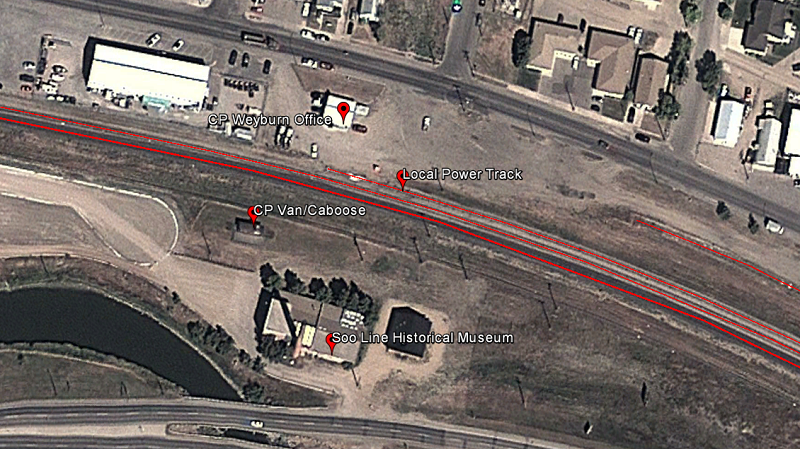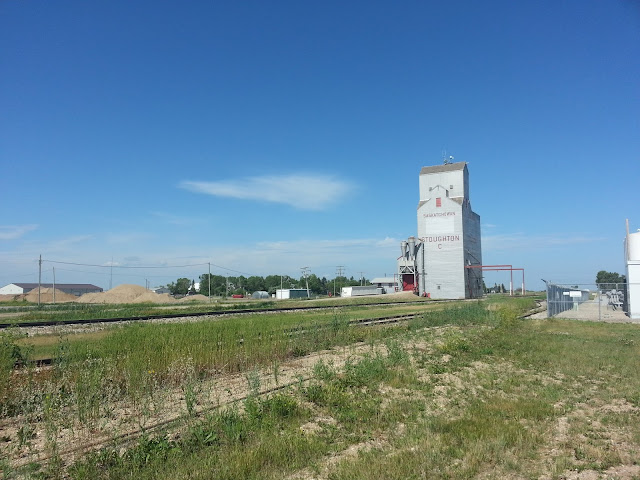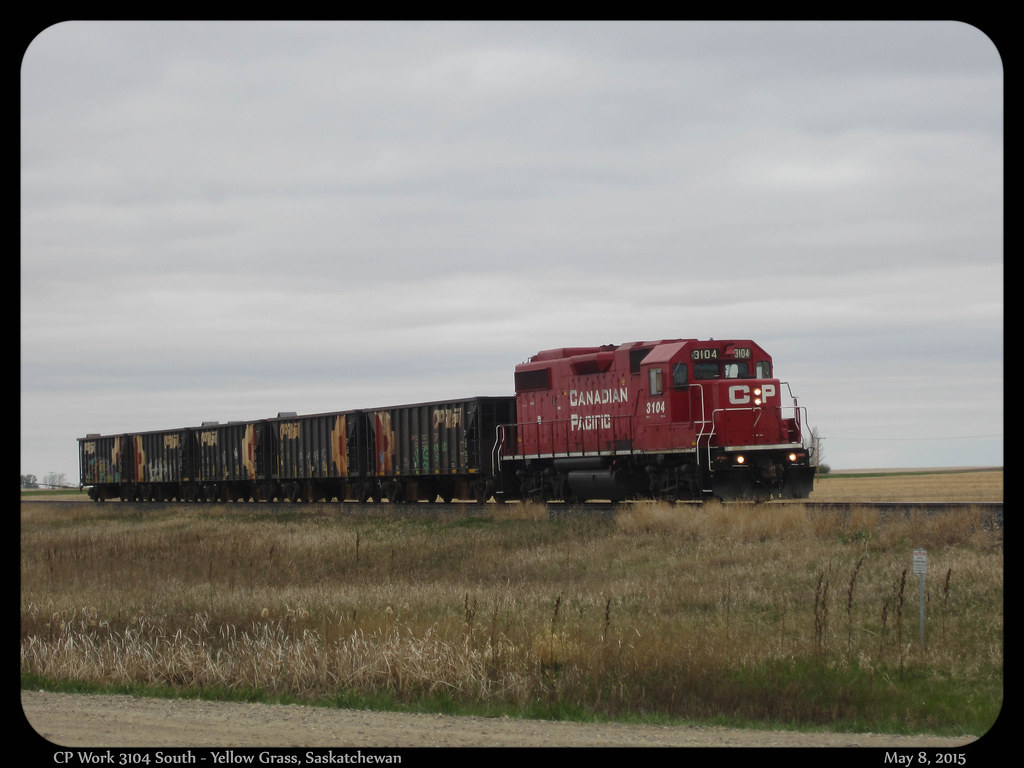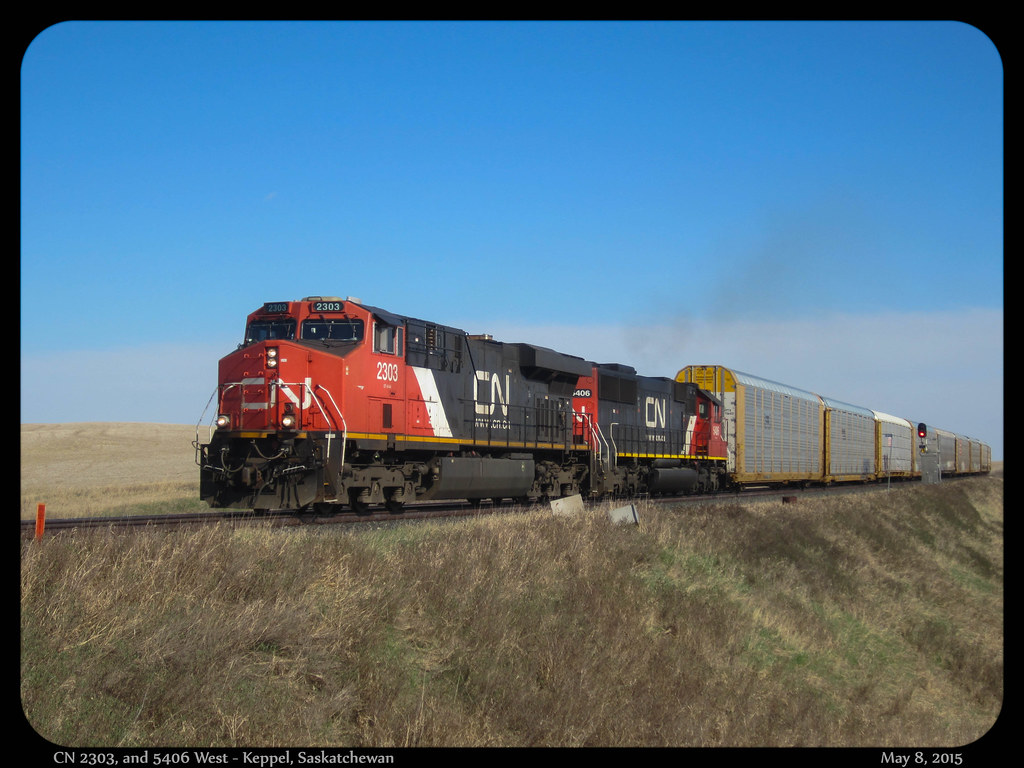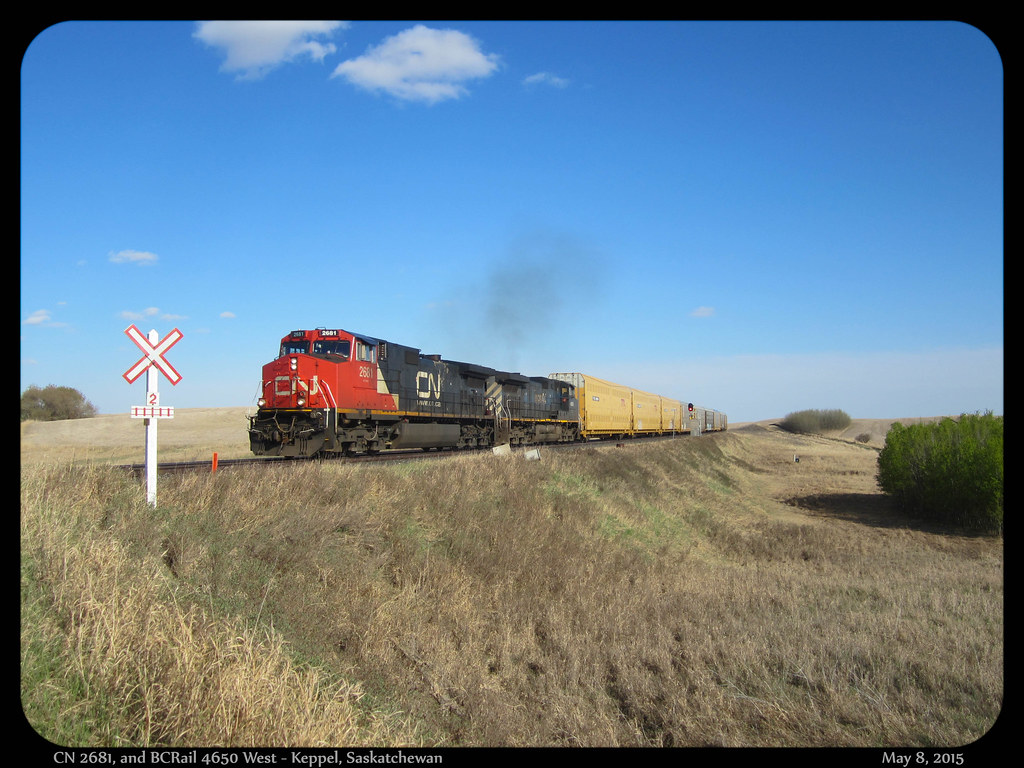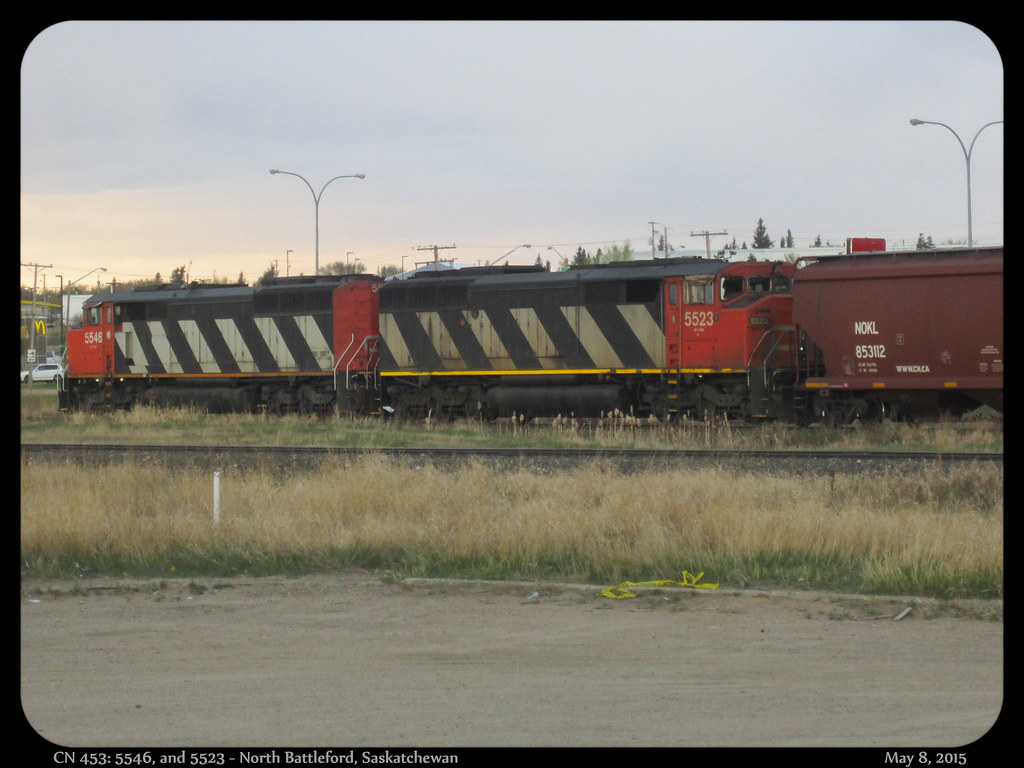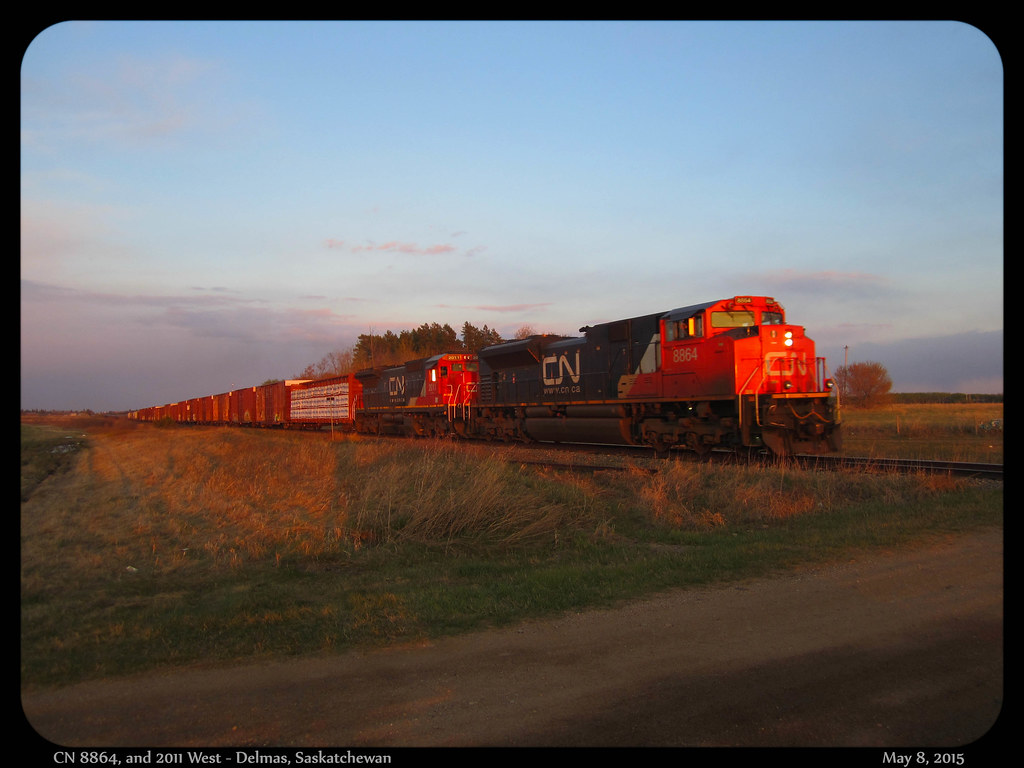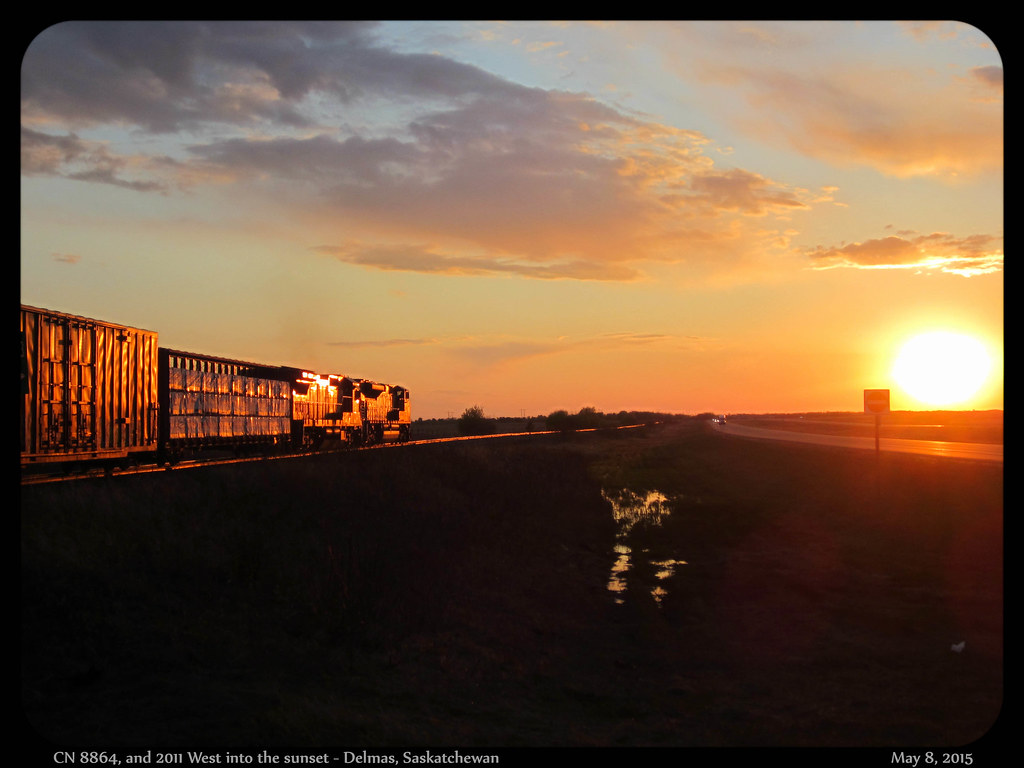Although currently there is only one railway line that runs through town, Weyburn was once full of railway activity. Because of this, we will begin by looking at the current and past railway lines of Weyburn starting in the east and moving west, before looking at the mainline that still operates.
In 1908 the Canadian Pacific's Kisbey Sub was extended from Stoughton to Weyburn, and was the first railway to operate in the area. Atfer the extension, this subdivision stretched west from Arcola to Weyburn by way of Stoughton where it met the Tyvan Sub. Although today the Kisbey Sub is no longer in existence, a small spur is still in use in Weyburn itself to service the Nexans plant. This remaining trackage sees less than one train a week, and I have yet to see a train on these tracks. If you were looking to shoot a train, Wednesday would likely be the best bet as CP tends to switch the local industries on that day.
 |
| Kisbey Sub Trackage in Weyburn |
 |
| Kisbey Sub tracks eastward towards Nexans. July 2015. |
Next we take a look at the former CN Weyburn Sub. This sub once ran from Talmage on CN's Lewvan Sub to Radville where it met the Goodwater Sub, the Avonlea Sub, and the Bengough Sub. In 1992 the Canadian Transportation Agency (CTA) approved CN's request to abandoned the sub from Talmage to a point near Weyburn. Also according to the CTA, 1994 marked the takeover of the Weyburn, and Bengough Subs by CP. This takeover was more of a trade by CN and CP where CN got CP's Meadow Lake Sub in return. This resulted in the Weyburn and Bengough Subs becoming the Radville Sub from Exon (Weyburn) on CP's Weyburn Sub, to Willow Bunch.
Present day, and the Radville Sub tracks are still in place. However, CP has not run a train over this line in quite sometime, and plans to abandon the line eventually. This is why I have marked the sub in burgundy south of the Wye near Exon. The Wye still sees trains that switch the local industries.
You will also notice that CN operated a Wye on the edge of town, as marked below. This Wye, and a former part of the Weyburn Sub north of the Wye are now part of the Tatagwa walking trail system. The southern portion of the trail ends just shy of CP's Weyburn Sub, and is a decent spot to shoot a few trains on that sub.
If you jump to minute 1:09 of this video, you will see the CP local tied down on the tracks to the ethanol plant (more on those tracks below), and CEFX 1036 hauling a train that was stored over night, off the Radville Sub.
Now we will take a look at the ethanol plant area, as well as the former Assiniboia Sub.
The Assiniboia Sub is a former CP line that ran west from Exon to Assiniboia. 1995 marked the end of this line in Weyburn, as the CTA gave CP permission to remove tracks from mile 0.6, west of Weyburn, to mile 36.5, just east of Pangman. The line west of mile 36.5 is still in service today after it was purchased from CP in 1999, and is now known as the Red Coat Road & Rail. The "Red Coat Road & Rail is an organization consisting of representatives of the communities adjacent to the rail line, including Rural Municipality No. 72 (Lake of the Rivers), RM No. 40 (Bengough), RM No. 71 (Excel), RM No. 70 (Key West), and RM No. 69 (Norton), as well as the villages of Ogema, Viceroy and Pangman." (Source). The Great Western Railway operates over this line on behalf of the Red Coat Road & Rail, and a tourist railway also operates on the line, but those are both for another post.
The 0.6 miles remaining in the Weyburn area are used to access the ethanol plant, as well as a few other small businesses nearby. The former Assiniboia tracks are now known as the Tatagwa Spur, and there is also the Promolas Spur, which gives access to the ethanol plant area. Currently, the ethanol plant itself is closed because of the downturn in fuel prices.
Of course with all of these railway lines running into Weyburn there had to be yards for the trains. Although a big chunk of the yards are now gone, a small bit is still here. As seen in the below snapshot, the Weyburn Siding gives access to the remaining yard tracks, of which there are four.
Present day, and the Radville Sub tracks are still in place. However, CP has not run a train over this line in quite sometime, and plans to abandon the line eventually. This is why I have marked the sub in burgundy south of the Wye near Exon. The Wye still sees trains that switch the local industries.
You will also notice that CN operated a Wye on the edge of town, as marked below. This Wye, and a former part of the Weyburn Sub north of the Wye are now part of the Tatagwa walking trail system. The southern portion of the trail ends just shy of CP's Weyburn Sub, and is a decent spot to shoot a few trains on that sub.
 |
| Former and current Weyburn/Radville Sub tracks |
If you jump to minute 1:09 of this video, you will see the CP local tied down on the tracks to the ethanol plant (more on those tracks below), and CEFX 1036 hauling a train that was stored over night, off the Radville Sub.
Now we will take a look at the ethanol plant area, as well as the former Assiniboia Sub.
The Assiniboia Sub is a former CP line that ran west from Exon to Assiniboia. 1995 marked the end of this line in Weyburn, as the CTA gave CP permission to remove tracks from mile 0.6, west of Weyburn, to mile 36.5, just east of Pangman. The line west of mile 36.5 is still in service today after it was purchased from CP in 1999, and is now known as the Red Coat Road & Rail. The "Red Coat Road & Rail is an organization consisting of representatives of the communities adjacent to the rail line, including Rural Municipality No. 72 (Lake of the Rivers), RM No. 40 (Bengough), RM No. 71 (Excel), RM No. 70 (Key West), and RM No. 69 (Norton), as well as the villages of Ogema, Viceroy and Pangman." (Source). The Great Western Railway operates over this line on behalf of the Red Coat Road & Rail, and a tourist railway also operates on the line, but those are both for another post.
The 0.6 miles remaining in the Weyburn area are used to access the ethanol plant, as well as a few other small businesses nearby. The former Assiniboia tracks are now known as the Tatagwa Spur, and there is also the Promolas Spur, which gives access to the ethanol plant area. Currently, the ethanol plant itself is closed because of the downturn in fuel prices.
 |
| Tracks associated with the former Assiniboia Sub |
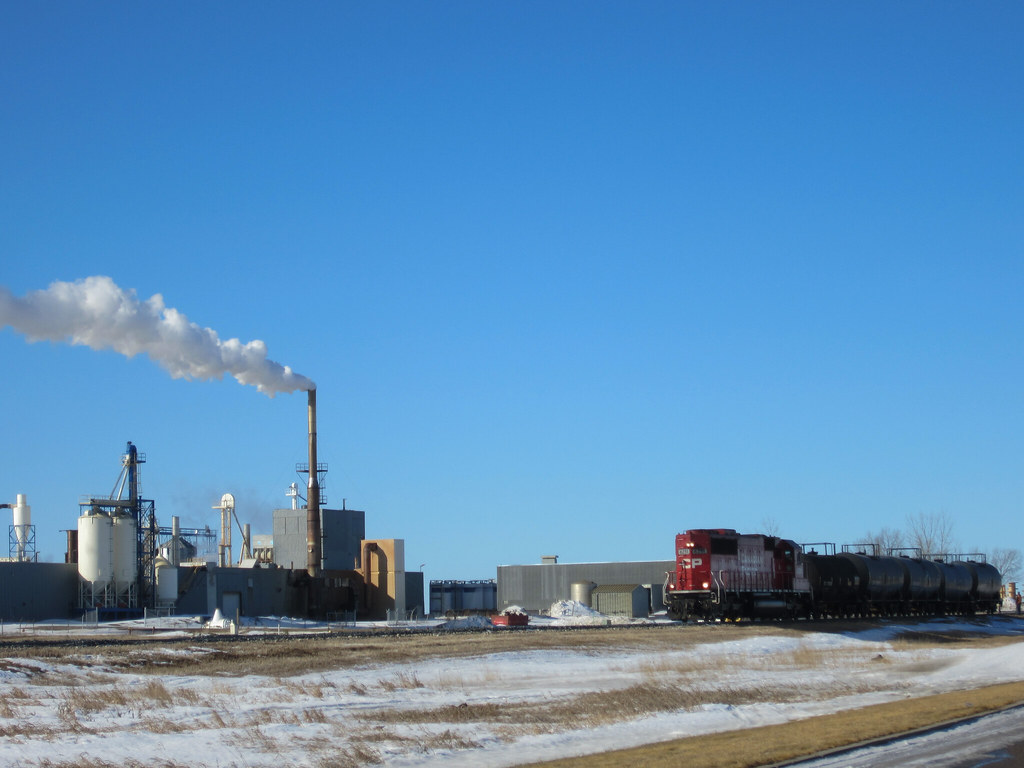 |
| CP Local on the Tatagwa Spur. Ethanol Plant in the background. March 2015. |
Of course with all of these railway lines running into Weyburn there had to be yards for the trains. Although a big chunk of the yards are now gone, a small bit is still here. As seen in the below snapshot, the Weyburn Siding gives access to the remaining yard tracks, of which there are four.
You may also notice that I have labelled the former roundhouse, and the proposed location for the CP shops. The roundhouse is now more than a century old and is used by the Weyburn Public Works department, and the shops were never built (to my knowledge).
Moving west, we see the Soo Line Historical Museum, and the CP Van. Here is the description of the museum from the Weyburn website: "A stroll through this Museum, housed in what was originally an electric utility power plant building, will peak your curiosity. It houses a collection of artifacts that were used by Weyburn and district pioneers, a collection of Native artifacts, the Soo Line Historical Archives plus the Charles Wilson Silver Collection. The Wilson Silver Collection is the largest one man collection of silver known to exist in Canada. There are more than 5,000 items dated from 1750 to 1972. You will view everything from full tea services to opera glasses and spoons. Mr. Wilson was a bachelor who lived on the family farm northwest of Weyburn. After a lifetime of attending auction sales, he chose to will his collection to the Soo Line Historical Museum so everyone might enjoy his lifetime of collecting."
The Van, CP 437254, was built in 1948, and is on display directly beside the museum.
Also marked below are the CP Weyburn office, and local power track (local trains tie their power down here).
I have yet to visit the museum itself, but have watched many trains roll by here. Below we see the CP Van with CP 9640, 8793 & 5708 heading north on the main track.
This next bit took a little more research. Each of the elevators, and tracks that serviced them are labelled below.
Although none of these elevators are still standing, there are newer bigger concrete ones that were built outside of town. Saskhistoryonline provides a number of good images of the old elevators, and as you may notice, a number of them were purchased and/or repainted over the years prior to being torn down.
Finally, we will take a look at CP's Weyburn Sub, and the new concrete elevators. The Weyburn Sub is now the last continuous line that runs through Weyburn. Beginning at North Portal on the U.S. border, the sub travels north-west through Estevan, Weyburn, and Wilcox, until its end at Pasqua where it meets CP's Canadian mainline in the form of the Indian Head Sub.
The Weyburn Sub is operated under the Occupancy Control System (OCS), but I have read that CP plans to install Centralized Traffic Control (CTC) and Automated Train Control System (ATCS) for the entire length of the sub. When that will happen is another question.
Labelled below are the Weyburn Sub itself, and the elevators still operating nearby.
The Viterra Elevator north-west of town was built in 1989, and had expansions in 1998, and 2000. The facility is serviced by three tracks.
Moving a bit closer to Weyburn, we see the Richardson Pioneer elevator.This facility was built in 2002 as a full service farm centre, and has four service tracks.
in the below video we see CP 8776 south rolling past both the Viterra and Pioneer elevators. The furthest being Viterra, and the closest being Pioneer.
Finally, we have the Parrish & Heimbecker elevator to the South-East of Weyburn. This elevator was built in 1975 with expansions in 1992, 1994, 1998, and 2002. It was also the first farmer owned inland terminal in Canada, but was purchased by P&H in 2014 after shareholders voted in favour of the sale.
Here we see CP 9810 leading a northbound train passing the P&H elevator on April 19, 2015.
That's all for now, but stay tuned for a post in the future about my favourite locations to shoot in the area.
Sources:
http://www.weyburn.ca/pdfs/2010cg.pdf
http://www.redcoatroadandrail.ca/
https://www.otc-cta.gc.ca/eng/ruling/150-r-1994
https://www.otc-cta.gc.ca/eng/ruling/1992-r-130
The Van, CP 437254, was built in 1948, and is on display directly beside the museum.
Also marked below are the CP Weyburn office, and local power track (local trains tie their power down here).
I have yet to visit the museum itself, but have watched many trains roll by here. Below we see the CP Van with CP 9640, 8793 & 5708 heading north on the main track.
This next bit took a little more research. Each of the elevators, and tracks that serviced them are labelled below.
Although none of these elevators are still standing, there are newer bigger concrete ones that were built outside of town. Saskhistoryonline provides a number of good images of the old elevators, and as you may notice, a number of them were purchased and/or repainted over the years prior to being torn down.
Finally, we will take a look at CP's Weyburn Sub, and the new concrete elevators. The Weyburn Sub is now the last continuous line that runs through Weyburn. Beginning at North Portal on the U.S. border, the sub travels north-west through Estevan, Weyburn, and Wilcox, until its end at Pasqua where it meets CP's Canadian mainline in the form of the Indian Head Sub.
The Weyburn Sub is operated under the Occupancy Control System (OCS), but I have read that CP plans to install Centralized Traffic Control (CTC) and Automated Train Control System (ATCS) for the entire length of the sub. When that will happen is another question.
Labelled below are the Weyburn Sub itself, and the elevators still operating nearby.
The Viterra Elevator north-west of town was built in 1989, and had expansions in 1998, and 2000. The facility is serviced by three tracks.
Moving a bit closer to Weyburn, we see the Richardson Pioneer elevator.This facility was built in 2002 as a full service farm centre, and has four service tracks.
in the below video we see CP 8776 south rolling past both the Viterra and Pioneer elevators. The furthest being Viterra, and the closest being Pioneer.
Finally, we have the Parrish & Heimbecker elevator to the South-East of Weyburn. This elevator was built in 1975 with expansions in 1992, 1994, 1998, and 2002. It was also the first farmer owned inland terminal in Canada, but was purchased by P&H in 2014 after shareholders voted in favour of the sale.
Here we see CP 9810 leading a northbound train passing the P&H elevator on April 19, 2015.
That's all for now, but stay tuned for a post in the future about my favourite locations to shoot in the area.
Sources:
http://www.weyburn.ca/pdfs/2010cg.pdf
http://www.redcoatroadandrail.ca/
https://www.otc-cta.gc.ca/eng/ruling/150-r-1994
https://www.otc-cta.gc.ca/eng/ruling/1992-r-130


